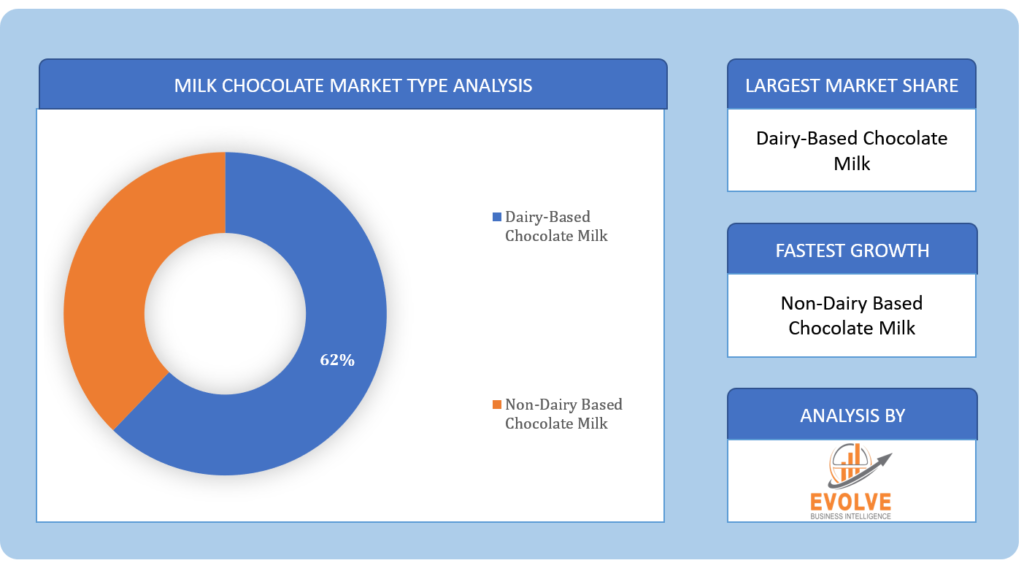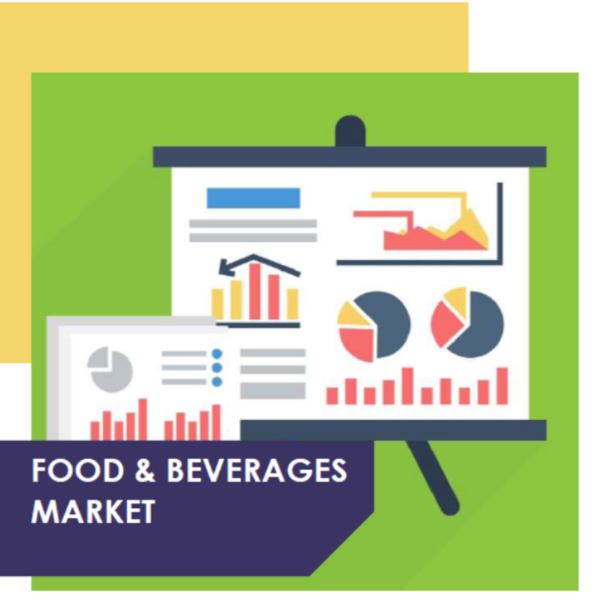Milk Chocolate Market Analysis and Global Forecast 2023-2033
$ 1,390.00 – $ 5,520.00Price range: $ 1,390.00 through $ 5,520.00
Milk Chocolate Market Research Report: Information By Type (Dairy-Based Chocolate Milk and Non-Dairy Based Chocolate Milk), By Distribution Channel (Supermarket/ Hypermarkets, Convenience Stores, Online Retail Stores, and Others), and by Region — Forecast till 2033
Milk Chocolate Market Overview
The Milk Chocolate Market Size is expected to reach USD 3.54 Billion by 2033. The Milk Chocolate industry size accounted for USD 1.01 Billion in 2023 and is expected to expand at a CAGR of 4.17% from 2023 to 2033. Milk chocolate is a type of chocolate that contains a significant proportion of milk solids in addition to cocoa solids and sugar. It is characterized by its smooth, creamy texture and sweet flavor profile, attributed to the presence of milk powder or condensed milk. The basic ingredients in milk chocolate typically include cocoa solids, sugar, milk solids, and cocoa butter. The addition of milk gives it a lighter color compared to dark chocolate and contributes to its milder taste. Milk chocolate is widely used in various confectionery products, such as bars, truffles, and assorted chocolates, and is a popular choice for baking and dessert applications.
Global Milk Chocolate Market Synopsis
The COVID-19 pandemic had a multifaceted impact on the Milk Chocolate market, with both challenges and opportunities arising. Initially, the market experienced disruptions in the supply chain, affecting production and distribution due to lockdowns and restrictions. However, as consumers sought comfort and indulgence during stressful times, there was an uptick in at-home consumption of chocolate products, including milk chocolate. The confectionery industry adapted by focusing on e-commerce channels and packaging innovations to meet changing consumer behaviors. Additionally, the pandemic prompted a surge in demand for premium and health-conscious chocolate options. The overall resilience of the Milk Chocolate market reflected its ability to navigate uncertainties, adapt to evolving consumer preferences, and leverage the enduring appeal of chocolate as a source of comfort and pleasure.
Milk Chocolate Market Dynamics
The major factors that have impacted the growth of Milk Chocolate are as follows:
Drivers:
Ø Growing Consumer Preference for Indulgent Treats and Premium Chocolates
The increasing consumer preference for indulgent treats and premium chocolates. As disposable incomes rise globally, consumers are more willing to spend on high-quality and premium chocolate products. Milk chocolate, known for its smooth and creamy texture, appeals to a wide consumer base, including children and adults. The demand for premium and artisanal chocolates has been on the rise, and milk chocolate, with its sweet and mild flavor profile, caters to this trend. Manufacturers often introduce innovative flavors and packaging to attract consumers seeking a luxurious and enjoyable chocolate experience.
Restraint:
- Health Concerns and Shift Towards Healthier Alternatives
The growing awareness of health issues associated with excessive consumption of sugar and unhealthy fats. Consumers are becoming more health-conscious, leading to a shift in preferences towards healthier snack options. Dark chocolate, with its higher cocoa content and perceived health benefits, has gained popularity among health-conscious consumers. The concern over obesity, diabetes, and other lifestyle-related diseases has prompted some consumers to reduce their intake of traditional milk chocolate products. Manufacturers are responding to this trend by introducing healthier formulations, such as sugar-free or low-sugar options, to address the health concerns associated with milk chocolate.
Opportunity:
⮚ Innovation in Flavors, Ingredients, and Packaging
The milk chocolate market lies in continuous innovation in flavors, ingredients, and packaging. Manufacturers can explore new and unique flavor combinations to appeal to diverse consumer tastes. Additionally, the use of premium and ethically sourced cocoa can be leveraged to attract environmentally and socially conscious consumers. Experimentation with exotic ingredients, such as fruits, nuts, and spices, can differentiate products in the market and create new avenues for growth. Moreover, innovative and sustainable packaging solutions can contribute to a positive brand image and attract environmentally conscious consumers. The emphasis on sustainability and ethical sourcing is an opportunity for milk chocolate manufacturers to align with consumer values and differentiate their products in a competitive market.
Milk Chocolate Segment Overview
By Type
 Based on Type, the market is segmented based on Dairy-Based Chocolate Milk and Non-Dairy Based Chocolate Milk. The Dairy-Based Chocolate Milk segment in the Milk Chocolate market is poised for substantial growth throughout the forecast period, driven by the increasing consumer demand for indulgent and nutritious beverage options, coupled with the inherent appeal of the creamy and rich taste of chocolate. This combination not only caters to consumers’ cravings for a delightful treat but also aligns with the growing emphasis on functional foods, where dairy-based chocolate milk is perceived as a source of essential nutrients, including calcium and proteins, providing a dual benefit of pleasure and nutritional value.
Based on Type, the market is segmented based on Dairy-Based Chocolate Milk and Non-Dairy Based Chocolate Milk. The Dairy-Based Chocolate Milk segment in the Milk Chocolate market is poised for substantial growth throughout the forecast period, driven by the increasing consumer demand for indulgent and nutritious beverage options, coupled with the inherent appeal of the creamy and rich taste of chocolate. This combination not only caters to consumers’ cravings for a delightful treat but also aligns with the growing emphasis on functional foods, where dairy-based chocolate milk is perceived as a source of essential nutrients, including calcium and proteins, providing a dual benefit of pleasure and nutritional value.
By Distribution Channel
Based on the Distribution Channel, the market has been divided into Supermarket/ Hypermarkets, Convenience Stores, Online Retail Stores, and Others. The Supermarket/Hypermarkets segment in the Milk Chocolate market is poised for substantial growth during the forecast period, attributed to the convenience and diverse product offerings these retail outlets provide, coupled with increasing consumer preference for one-stop shopping experiences, driving the accessibility and widespread availability of milk chocolate products.
Global Milk Chocolate Market Regional Analysis
Based on region, the global Milk Chocolate market has been divided into North America, Europe, Asia-Pacific, the Middle East & Africa, and Latin America. North America is projected to dominate the use of the Milk Chocolate market followed by the Asia-Pacific and Europe regions.
 Milk Chocolate North America Market
Milk Chocolate North America Market
North America has consistently maintained a dominant position in the Milk Chocolate market, owing to the region’s well-established chocolate confectionery industry, robust consumer demand, and a culture of chocolate consumption. The United States and Canada, in particular, boast a strong affinity for sweet indulgences, with a high per capita chocolate consumption rate. Premiumization trends and a penchant for innovative flavors have further fueled the market’s growth, as consumers seek unique and high-quality chocolate experiences. The presence of key industry players, strategic marketing initiatives, and a sophisticated retail landscape, including specialty chocolate shops and supermarket chains, contribute to North America’s enduring leadership in the milk chocolate sector. Additionally, the region’s dynamic consumer preferences, characterized by a balance of traditional favorites and a growing interest in premium and artisanal offerings, continue to drive sustained growth in the North American Milk Chocolate market.
Milk Chocolate Asia-Pacific Market
The Asia-Pacific region has experienced a rapid and remarkable surge in the Milk Chocolate industry, fueled by shifting consumer preferences, rising disposable incomes, and a growing urban population. The region’s expanding middle class, particularly in countries such as China and India, has developed a taste for confectionery products, contributing to the increasing demand for milk chocolate. Furthermore, the influence of Western lifestyles and the adoption of chocolate as a popular gift item and festive treat have boosted market growth. International chocolate brands have capitalized on these trends by introducing a diverse range of products and flavors tailored to local tastes. The expanding retail infrastructure, including the proliferation of supermarkets and convenience stores, has enhanced accessibility, making milk chocolate a widely available and sought-after indulgence in the Asia-Pacific market. The combination of evolving consumer preferences, economic growth, and strategic market penetration has propelled the remarkable surge in the Milk Chocolate industry across the Asia-Pacific region.
Competitive Landscape
The Global Milk Chocolate market is highly competitive, with numerous players offering a wide range of solutions. The competitive landscape is characterized by the presence of established companies, as well as emerging startups and niche players. To increase their market position and attract a wide consumer base, the businesses are employing various strategies, such as product launches, and strategic alliances.
Prominent Players:
- Cadbury (Mondelez International)
- Lindt & Sprüngli
- Hershey’s
- Nestlé
- Ferrero
- Mars, Incorporated
- Godiva
- Ghirardelli
- Milka
- Toblerone
Key Development:
In December 2022, Nestlé, a global leader in the food and beverage industry, introduced its Cowabunga brand of dairy-free beverages to selected grocery stores in San Francisco, United States. Developed in partnership with Perfect Day, a California-based company specializing in the precise fermentation of animal-free whey, this new line of drinks offers calcium and vitamin D fortification. The beverages, available in two flavors—plain milk and chocolate—underscore Nestlé’s commitment to providing innovative, plant-based alternatives through cutting-edge collaborations.
Scope of the Report
Global Milk Chocolate Market, by Type
- Dairy-Based Chocolate Milk
- Non-Dairy Based Chocolate Milk
Global Milk Chocolate Market, by Distribution Channel
- Supermarket/ Hypermarkets
- Convenience Stores
- Online Retail Stores
- Other
Global Milk Chocolate Market, by Region
- North America
- US
- Canada
- Mexico
- Europe
- UK
- Germany
- France
- Italy
- Spain
- Benelux
- Nordic
- Rest of Europe
- Asia Pacific
- China
- Japan
- South Korea
- Indonesia
- Austalia
- Malaysia
- India
- Rest of Asia Pacific
- South America
- Brazil
- Argentina
- Rest of South America
- Middle East & Africa
- Saudi Arabia
- UAE
- Egypt
- South Africa
- Rest of Middle East & Africa
| Parameters | Indicators |
|---|---|
| Market Size | 2033: $3.54 Billion |
| CAGR | 4.17% CAGR (2023-2033) |
| Base year | 2022 |
| Forecast Period | 2023-2033 |
| Historical Data | 2021 |
| Report Coverage | Revenue Forecast, Competitive Landscape, Growth Factors, and Trends |
| Key Segmentations | Type, Distribution Channel |
| Geographies Covered | North America, Europe, Asia-Pacific, Latin America, Middle East, Africa |
| Key Vendors | Gap Inc, Aditya Birla Management Corporation Pvt. Ltd, Industria de Diseño Textil, S.A., Kering SA, Nike Inc, PVH Corp, Adidas AG, Burberry Group PLC, Hermès International, H & M Hennes & Mauritz |
| Key Market Opportunities | • Growing consumer awareness of health issues drives the opportunity for healthier formulations, such as low-sugar or sugar-free milk chocolate. • Exploration of sustainable and ethical sourcing practices for cocoa appeals to environmentally and socially conscious consumers. |
| Key Market Drivers | • Increasing consumer preference for premium and artisanal chocolate products. • Rising disposable incomes contribute to a willingness to spend on high-quality and indulgent treats. |
REPORT CONTENT BRIEF:
- High-level analysis of the current and future Milk Chocolate market trends and opportunities
- Detailed analysis of current market drivers, restraining factors, and opportunities in the future
- Milk Chocolate market historical market size for the year 2021, and forecast from 2023 to 2033
- Milk Chocolate market share analysis at each product level
- Competitor analysis with detailed insight into its product segment, Government and defense strength, and strategies adopted.
- Identifies key strategies adopted including product launches and developments, mergers and acquisitions, joint ventures, collaborations, and partnerships as well as funding taken and investment done, among others.
- To identify and understand the various factors involved in the global Milk Chocolate market affected by the pandemic
- To provide a detailed insight into the major companies operating in the market. The profiling will include the Government and defense health of the company’s past 2-3 years with segmental and regional revenue breakup, product offering, recent developments, SWOT analysis, and key strategies.
Press Release

Global Pharmaceutical Manufacturing Market to Reach $1.38 Trillion by 2035 with 7.35% CAGR, New Research Shows

The Global Mammography Market Is Estimated To Record a CAGR of Around 10.29% During The Forecast Period

Glue Stick Market to Reach USD 2.35 Billion by 2034

Podiatry Service Market to Reach USD 11.88 Billion by 2034

Microfluidics Technology Market to Reach USD 32.58 Billion by 2034

Ferric Chloride Market to Reach USD 10.65 Billion by 2034

Family Practice EMR Software Market to Reach USD 21.52 Billion by 2034

Electric Hairbrush Market to Reach USD 15.95 Billion by 2034

Daily Bamboo Products Market to Reach USD 143.52 Billion by 2034

Cross-border E-commerce Logistics Market to Reach USD 112.65 Billion by 2034
Frequently Asked Questions (FAQ)
What is the study period of the Milk Chocolate Market?
The study period encompasses historical data from 2021 and forecasts for the years 2023 to 2033.
What is the growth rate of the Milk Chocolate Market?
The Milk Chocolate market is expected to grow at a steady compound annual growth rate (CAGR) of 4.17% from 2023 to 2033.
Which region has the highest growth rate in the Milk Chocolate Market?
The Asia-Pacific region is projected to experience the highest growth rate in the Milk Chocolate market, driven by shifting consumer preferences, rising disposable incomes, and a growing urban population.
Which region has the largest share of the Milk Chocolate Market?
Currently, North America holds the largest share in the Milk Chocolate market, attributed to its well-established chocolate confectionery industry, robust consumer demand, and a culture of chocolate consumption.
Who are the key players in the Milk Chocolate Market?
Key players in the Milk Chocolate market include Cadbury (Mondelez International), Lindt & Sprüngli, Hershey’s, Nestlé, Ferrero, Mars, Incorporated, Godiva, Ghirardelli, Milka, and Toblerone, among others.
Do you offer Post sales support?
Yes, we offer 16 hours of analyst support to solve the queries
Do you sell particular sections of a report?
Yes, we provide regional as well as country-level reports. Other than this we also provide a sectional report. Please get in contact with our sales representatives.
Table of Content
Chapter 1. Executive Summary Chapter 2. Scope Of The Study 2.1. Market Definition 2.2. Scope Of The Study 2.2.1. Objectives of Report 2.2.2. Limitations 2.3. Market Structure Chapter 3. Evolve BI Methodology Chapter 4. Market Insights and Trends 4.1. Supply/ Value Chain Analysis 4.1.1. Raw Material Providers 4.1.2. Manufacturing Process 4.1.3. Distributors/Retailers 4.1.4. End-Use Industry 4.2. Porter’s Five Forces Analysis 4.2.1. Threat Of New Entrants 4.2.2. Bargaining Power Of Buyers 4.2.3. Bargaining Power Of Suppliers 4.2.4. Threat Of Substitutes 4.2.5. Industry Rivalry 4.3. Impact Of COVID-19 on the Milk Chocolate Market 4.3.1. Impact on Market Size 4.3.2. End-Use Industry Trend, Preferences, and Budget Impact 4.3.3. Regulatory Framework/Government Policies 4.3.4. Key Players' Strategy to Tackle Negative Impact 4.3.5. Opportunity Window 4.4. Distribution Channel Overview 12.28. Macro factor 4.6. Micro Factor 4.7. Demand Supply Gap Analysis of the Milk Chocolate Market 4.8. Import Analysis of the Milk Chocolate Market 4.9. Export Analysis of the Milk Chocolate Market Chapter 5. Market Dynamics 5.1. Introduction 5.2. DROC Analysis 5.2.1. Drivers 5.2.2. Restraints 5.2.3. Opportunities 5.2.4. Challenges 5.3. Patent Analysis 5.4. Industry Roadmap 5.5. Parent/Peer Market Analysis Chapter 6. Global Milk Chocolate Market, By Type 6.1. Introduction 6.2. Dairy-Based Chocolate Milk 6.3. Non-Dairy Based Chocolate Milk Chapter 7. Global Milk Chocolate Market, By Distribution Channel 7.1. Introduction 7.2. Supermarkets/ Hypermarkets 7.3. Convenience Stores 7.4. Online Retail Stores 7.5. Other Chapter 8. Global Milk Chocolate Market, By Region 8.1. Introduction 8.2. North America 8.2.1. Introduction 8.2.2. Driving Factors, Opportunity Analyzed, and Key Trends 8.2.3. Market Size and Forecast, By Country, 2023-2033 8.2.4. Market Size and Forecast, By Derivatives Type, 2023-2033 8.2.5. Market Size and Forecast, By Function Types, 2023-2033 8.2.6. US 8.2.6.1. Introduction 8.2.6.2. Driving Factors, Opportunity Analyzed, and Key Trends 8.2.6.3. Market Size and Forecast, By Type, 2023-2033 8.2.6.4. Market Size and Forecast, By Distribution Channel, 2023-2033 8.2.7. Canada 8.2.7.1. Introduction 8.2.7.2. Driving Factors, Opportunity Analyzed, and Key Trends 8.2.7.4. Market Size and Forecast, By Type, 2023-2033 8.2.7.5. Market Size and Forecast, By Distribution Channel, 2023-2033 8.3. Europe 8.3.1. Introduction 8.3.2. Driving Factors, Opportunity Analyzed, and Key Trends 8.3.3. Market Size and Forecast, By Country, 2023-2033 8.3.4. Market Size and Forecast, By Type, 2023-2033 8.3.5. Market Size and Forecast, By Distribution Channel, 2023-2033 8.3.6. Germany 8.3.6.1. Introduction 8.3.6.2. Driving Factors, Opportunity Analyzed, and Key Trends 8.3.6.3. Market Size and Forecast, By Type, 2023-2033 8.3.6.4. Market Size and Forecast, By Distribution Channel, 2023-2033 8.3.7. France 8.3.7.1. Introduction 8.3.7.2. Driving Factors, Opportunity Analyzed, and Key Trends 8.3.7.3. Market Size and Forecast, By Type, 2023-2033 8.3.7.4. Market Size and Forecast, By Distribution Channel, 2023-2033 8.3.8. UK 8.3.8.1. Introduction 8.3.8.2. Driving Factors, Opportunity Analyzed, and Key Trends 8.3.8.3. Market Size and Forecast, By Type, 2023-2033 8.3.8.4. Market Size and Forecast, By Distribution Channel, 2023-2033 8.3.9. Italy 8.3.9.1. Introduction 8.3.9.2. Driving Factors, Opportunity Analyzed, and Key Trends 8.3.9.3. Market Size and Forecast, By Type, 2023-2033 8.3.9.4. Market Size and Forecast, By Distribution Channel, 2023-2033 8.3.11. Rest Of Europe 8.3.11.1. Introduction 8.3.11.2. Driving Factors, Opportunity Analyzed, and Key Trends 8.3.11.3. Market Size and Forecast, By Type, 2023-2033 8.3.11.4. Market Size and Forecast, By Distribution Channel, 2023-2033 8.4. Asia-Pacific 8.4.1. Introduction 8.4.2. Driving Factors, Opportunity Analyzed, and Key Trends 8.4.3. Market Size and Forecast, By Country, 2023-2033 8.4.4. Market Size and Forecast, By Type, 2023-2033 8.12.28. Market Size and Forecast, By Distribution Channel, 2023-2033 8.4.6. China 8.4.6.1. Introduction 8.4.6.2. Driving Factors, Opportunity Analyzed, and Key Trends 8.4.6.3. Market Size and Forecast, By Type, 2023-2033 8.4.6.4. Market Size and Forecast, By Distribution Channel, 2023-2033 8.4.7. India 8.4.7.1. Introduction 8.4.7.2. Driving Factors, Opportunity Analyzed, and Key Trends 8.4.7.3. Market Size and Forecast, By Type, 2023-2033 8.4.7.4. Market Size and Forecast, By Distribution Channel, 2023-2033 8.4.8. Japan 8.4.8.1. Introduction 8.4.8.2. Driving Factors, Opportunity Analyzed, and Key Trends 8.4.8.3. Market Size and Forecast, By Type, 2023-2033 8.4.8.4. Market Size and Forecast, By Distribution Channel, 2023-2033 8.4.9. South Korea 8.4.9.1. Introduction 8.4.9.2. Driving Factors, Opportunity Analyzed, and Key Trends 8.4.9.3. Market Size and Forecast, By Type, 2023-2033 8.4.9.4. Market Size and Forecast, By Distribution Channel, 2023-2033 8.4.10. Rest Of Asia-Pacific 8.4.10.1. Introduction 8.4.10.2. Driving Factors, Opportunity Analyzed, and Key Trends 8.4.10.3. Market Size and Forecast, By Type, 2023-2033 8.4.10.4. Market Size and Forecast, By Distribution Channel, 2023-2033 8.5. Rest Of The World (RoW) 8.5.1. Introduction 8.5.2. Driving Factors, Opportunity Analyzed, and Key Trends 8.5.3. Market Size and Forecast, By Type, 2023-2033 8.5.4. Market Size and Forecast, By Distribution Channel, 2023-2033 Chapter 9. Company Landscape 9.1. Introduction 9.2. Vendor Share Analysis 9.3. Key Development Analysis 9.4. Competitor Dashboard Chapter 10. Company Profiles 10.1. Cadbury (Mondelez International) 10.1.1. Business Overview 10.1.2. Government & Defense Analysis 10.1.2.1. Government & Defense – Existing/Funding 10.1.3. Product Portfolio 10.1.4. Recent Development and Strategies Adopted 10.1.5. SWOT Analysis 10.2. Lindt & Sprüngli 10.2.1. Business Overview 10.2.2. Government & Defense Analysis 10.2.2.1. Government & Defense – Existing/Funding 10.2.3. Product Portfolio 10.2.4. Recent Development and Strategies Adopted 10.2.5. SWOT Analysis 10.3. Hershey's 10.3.1. Business Overview 10.3.2. Government & Defense Analysis 10.3.2.1. Government & Defense – Existing/Funding 10.3.3. Product Portfolio 10.3.4. Recent Development and Strategies Adopted 10.3.5. SWOT Analysis 10.4. Nestlé 10.4.1. Business Overview 10.4.2. Government & Defense Analysis 10.4.2.1. Government & Defense – Existing/Funding 10.4.3. Product Portfolio 10.4.4. Recent Development and Strategies Adopted 10.4.5. SWOT Analysis 10.5. Ferrero 10.5.1. Business Overview 10.5.2. Government & Defense Analysis 10.5.2.1. Government & Defense – Existing/Funding 10.5.3. Product Portfolio 10.5.4. Recent Development and Strategies Adopted 10.5.5. SWOT Analysis 10.6. Mars, Incorporated 10.6.1. Business Overview 10.6.2. Government & Defense Analysis 10.6.2.1. Government & Defense – Existing/Funding 10.6.3. Product Portfolio 10.6.4. Recent Development and Strategies Adopted 10.6.5. SWOT Analysis 10.7. Godiva 10.7.1. Business Overview 10.7.2. Government & Defense Analysis 10.7.2.1. Government & Defense – Existing/Funding 10.7.3. Product Portfolio 10.7.4. Recent Development and Strategies Adopted 10.7.5. SWOT Analysis 10.8 Ghirardelli 10.8.1. Business Overview 10.8.2. Government & Defense Analysis 10.8.2.1. Government & Defense – Existing/Funding 10.8.3. Product Portfolio 10.8.4. Recent Development and Strategies Adopted 10.8.5. SWOT Analysis 10.9 Milka 10.9.1. Business Overview 10.9.2. Government & Defense Analysis 10.9.2.1. Government & Defense – Existing/Funding 10.9.3. Product Portfolio 10.9.4. Recent Development and Strategies Adopted 10.9.5. SWOT Analysis 10.10. Toblerone 10.10.1. Business Overview 10.10.2. Government & Defense Analysis 10.10.2.1. Government & Defense – Existing/Funding 10.10.3. Product Portfolio 10.10.4. Recent Development and Strategies Adopted 10.10.5. SWOT Analysis
Connect to Analyst
Research Methodology











